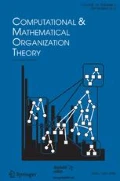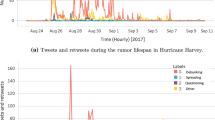Abstract
Online social networks allow users to share a variety of multi-media content on the World Wide Web. The rising popularity of such social networking platforms coupled with limitations in verifying the veracity of shared content has contributed to increase in misinformation on these media. Misinformation content such as fake-news and hoaxes, though often considered innocuous, may have high social cost such as influencing elections decision, and thus should be investigated carefully. Many researchers have studied various aspects of fake-news including automated ways to recognize it. However, a large-scale study comparing the sharing patterns of fake-news and trusted-news is missing. In this research, we take Ukraine, a country where fake news is common, as a case study. Using datasets generated by three different Tweets collection strategies, we present an anatomical comparison of fake-news and trusted-news sharing pattern on Twitter. Such a comparison enables to identify the characteristics of tweets sharing fake-news, and allows to find the users who are more inclined to share misinformation. Besides, we also study possible bot activities in the dataset. The top conclusions derived from this study are (a) Users sharing fake-news stories are more likely to include hashtags, and the hashtags used in Tweets sharing fake-news stories are similar to hashtags used in Tweets sharing trusted news. (b) Users sharing fake-news are also more likely to include mentions, but mentions used in tweets sharing fake-news and trusted-news are often different. (c) Tweets sharing fake-news have more negative sentiment. In contrast, tweets sharing trusted-news have more positive sentiment.















Similar content being viewed by others
Notes
References
Adamic LA, Huberman BA (2000) Power-law distribution of the World Wide Web. Science 287(5461):2115–2115
Allcott H, Gentzkow M (2017) Social media and fake news in the 2016 election. J Econ Perspect 31(2):211–36
Alstott J, Bullmore E, Plenz D (2014) powerlaw: a python package for analysis of heavy-tailed distributions. PLoS ONE 9(1):e85,777
Bertot JC, Jaeger PT, Hansen D (2012) The impact of polices on government social media usage: issues, challenges, and recommendations. Gov Inf Q 29(1):30–40
Buccafurri F, Lax G, Nocera A, Ursino D (2012) Discovering links among social networks. In: Joint European conference on machine learning and knowledge discovery in databases, Springer, pp 467–482
Carley KM (2014) Ora: a toolkit for dynamic network analysis and visualization. In: Alhajj R, Rokne J (eds) Encyclopedia of social network analysis and mining. Springer, New York, pp 1219–1228
Chu Z, Gianvecchio S, Wang H, Jajodia S (2010) Who is tweeting on Twitter: human, bot, or cyborg? In: Proceedings of the 26th annual computer security applications conference, ACM, pp 21–30
Clauset A, Shalizi CR, Newman ME (2009) Power-law distributions in empirical data. SIAM Rev 51(4):661–703
Conroy NJ, Rubin VL, Chen Y (2015) Automatic deception detection: methods for finding fake news. Proc Assoc Inf Sci Technol 52(1):1–4
Davis CA, Varol O, Ferrara E, Flammini A, Menczer F (2016) Botornot: A system to evaluate social bots. In: Proceedings of the 25th international conference companion on world wide web, international World Wide Web Conferences Steering Committee, pp 273–274
Davoust A, Floyd MW, Esfandiari B (2008) Use of fuzzy histograms to model the spatial distribution of objects in case-based reasoning. In: Conference of the Canadian Society for Computational Studies of Intelligence, Springer, pp 72–83
Dickerson JP, Kagan V, Subrahmanian V (2014) Using sentiment to detect bots on twitter: Are humans more opinionated than bots? In: 2014 IEEE/ACM international conference on advances in social networks analysis and mining (ASONAM), IEEE, pp 620–627
Du N, Wu B, Pei X, Wang B, Xu L (2007) Community detection in large-scale social networks. In: Proceedings of the 9th WebKDD and 1st SNA-KDD 2007 workshop on Web mining and social network analysis, ACM, pp 16–25
Ellison NB, Steinfield C, Lampe C (2007) The benefits of Facebook “friends:” social capital and college students’ use of online social network sites. J Comput Mediat Commun 12(4):1143–1168
Ferrara E (2015) Manipulation and abuse on social media. ACM SIGWEB Newsletter (Spring), New York
Ferrara E, Varol O, Davis C, Menczer F, Flammini A (2014) The rise of social bots. arXiv:1407.5225
Hassan N, Li C, Tremayne M (2015) Detecting check-worthy factual claims in presidential debates. In: Proceedings of the 24th ACM international on conference on information and knowledge management, ACM, pp 1835–1838
Hutto, CJ, Gilbert E (2014) Vader: a parsimonious rule-based model for sentiment analysis of social media text. In: Eighth international AAAI conference on weblogs and social media
Ioffe S (2010) Improved consistent sampling, weighted minhash and l1 sketching. In: 2010 IEEE 10th international conference on data mining (ICDM), IEEE, pp 246–255
Jin Z, Cao J, Zhang Y, Luo J (2016) News verification by exploiting conflicting social viewpoints in microblogs. In: AAAI, pp 2972–2978
Khaldarova I, Pantti M (2016) Fake news: the narrative battle over the Ukrainian conflict. Journal Pract 10(7):891–901
Kumar S, Carley KM (2016) Approaches to understanding the motivations behind cyber attacks. In: 2016 IEEE international conference on intelligence and security informatics (ISI), Tucson, Arizona USA
Kumar S, Carley KM (2018) People2vec: Learning latent representations of users using their social-media activities. In: international conference on social computing, behavioral-cultural modeling and prediction and behavior representation in modeling and simulation, Springer, pp 154–163
Lee K, Eoff BD, Caverlee J (2011) Seven months with the devils: a long-term study of content polluters on twitter. In: ICWSM
Morstatter F, Wu L, Nazer TH, Carley KM, Liu H (2016) A new approach to bot detection: striking the balance between precision and recall. In: 2016 IEEE/ACM international conference on advances in social networks analysis and mining (ASONAM), IEEE, pp 533–540
Newman N, Fletcher R, Kalogeropoulos A, Levy DA, Nielsen RK (2017) Reuters institute digital news report 2017
Parkinson HJ (2016) Click and elect: how fake news helped Donald Trump win a real election. The Guardian
Pfeffer J, Zorbach T, Carley KM (2014) Understanding online firestorms: negative word-of-mouth dynamics in social media networks. J Market Commun 20(1–2):117–128
Rashkin H, Choi E, Jang JY, Volkova S, Choi Y (2017) Truth of varying shades: analyzing language in fake news and political fact-checking. In: proceedings of the 2017 conference on empirical methods in natural language processing, pp 2921–2927
Rubin VL, Lukoianova T (2015) Truth and deception at the rhetorical structure level. J Assoc Inf Sci Technol 66(5):905–917
Rubin V, Conroy N, Chen Y, Cornwell S (2016) Fake news or truth? Using satirical cues to detect potentially misleading news. In: proceedings of the second workshop on computational approaches to deception detection, pp 7–17
Samanth S (2017) Inside the macedonian fake-news complex. Wired.com. https://www.wired.com/2017/02/veles-macedonia-fake-news/
Schifferes S, Newman N, Thurman N, Corney D, Göker A, Martin C (2014) Identifying and verifying news through social media: developing a user-centred tool for professional journalists. Digit Journal 2(3):406–418
Shao C, Ciampaglia GL, Varol O, Flammini A, Menczer F (2017) The spread of fake news by social bots. arXiv:1707.07592
Shi B, Weninger T (2016) Fact checking in heterogeneous information networks. In: Proceedings of the 25th international conference companion on World Wide Web, International World Wide Web Conferences Steering Committee, pp 101–102
Shu K, Wang S, Sliva A, Tang J, Liu H (2017) Fake news detection on social media: a data mining perspective. arXiv:1708.01967
Tacchini E, Ballarin G, Della Vedova ML, Moret S, de Alfaro L (2017) Some like it hoax: automated fake news detection in social networks. arXiv:1704.07506
Vargo CJ, Guo L, Amazeen MA (2017) The agenda-setting power of fake news: a big data analysis of the online media landscape from 2014 to 2016. New Media Soc 20:2028–2049
Volkova S, Shaffer K, Jang JY, Hodas N (2017) Separating facts from fiction: Linguistic models to classify suspicious and trusted news posts on twitter. In: Proceedings of the 55th annual meeting of the association for computational linguistics (Volume 2: Short Papers), vol 2, pp 647–653
Vosoughi S, Roy D, Aral S (2018) The spread of true and false news online. Science 359(6380):1146–1151. https://doi.org/10.1126/science.aap9559
Wang Y, Ma F, Jin Z, Yuan Y, Xun G, Jha K, Su L, Gao J (2018) Eann: event adversarial neural networks for multi-modal fake news detection
Funding
Funding was provided by MURI (Grant Nos. N000140811186 and N000141712675).
Author information
Authors and Affiliations
Corresponding authors
Additional information
Publisher's Note
Springer Nature remains neutral with regard to jurisdictional claims in published maps and institutional affiliations.
Electronic supplementary material
Below is the link to the electronic supplementary material.
Rights and permissions
About this article
Cite this article
Kumar, S., Huang, B., Cox, R.A.V. et al. An anatomical comparison of fake-news and trusted-news sharing pattern on Twitter. Comput Math Organ Theory 27, 109–133 (2021). https://doi.org/10.1007/s10588-019-09305-5
Published:
Issue Date:
DOI: https://doi.org/10.1007/s10588-019-09305-5




